Facts about China: Education
UPDATED:10:13 09 September 2015 by amy
China Mike’s 100% verified, no B.S. China facts (interesting & fun statistics):
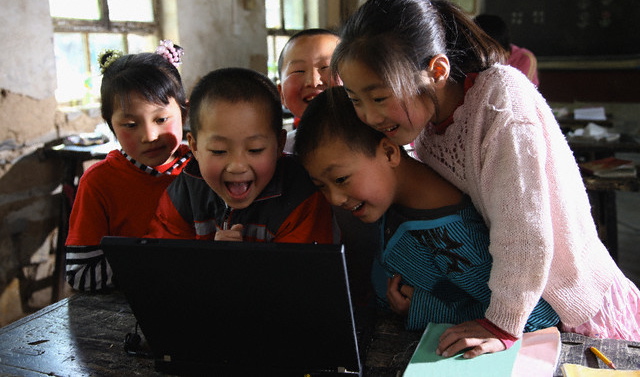
China’s literacy rate: (age 15+ who can read and write)
total population: 91.6%
male: 95.7%
female: 87.6%
School life expectancy (primary to tertiary education):
male: 11 years
female: 12 years (2009)
Education expenditures:
1.9% of GDP
Global rank: #172
[ Source: CIA World Factbook, accessed 2011 ]
China facts: LITERACY RATES
Literacy rate defined as knowledge of 1,500 Chinese characters in rural locations and 2,000 characters in urban areas.
[ “China: Asia in Focus”, R. LaFleur 2010]
Before the Communist party took power in 1949, about 80% of China’s population was illiterate. Enrollment rate was below 20% for elementary school and about 6% of junior secondary school.
[China.org.cn “60 Years of Educational Reform and Development” Sept. 14, 2009 ]
By 2008, adult illiteracy rate in China dropped to only 3.58%. Elementary school and junior secondary school enrollment jumped to 99.5% and 98.5% respectively.
[China.org.cn “60 Years of Educational Reform and Development” Sept. 14, 2009 ]
Today, Chinese youth (15-24 years) have a 99% literacy rate.
[Unicef, 2004-2008 data ]
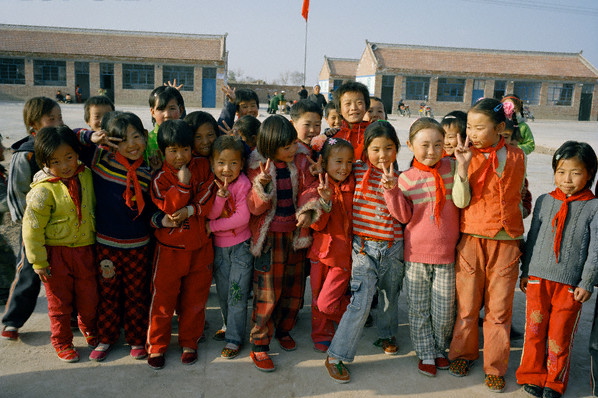
EDUCATION INVESTMENT & PERFORMANCE
Since 1998, China has invested in “a massive expansion of education, nearly tripling the share of GDP devoted to it. In the decade since, the number of colleges in China has doubled and the number of students quintupled, going from 1 million in 1997 to 5.5 million in 2007.”
[Time Mag. “The Real Challenge from China: Its People, Not Its Currency” Oct. 7, 2010 ]
Students from Shanghai’s schools outperformed those from 65 countries/regions, according to report by the Organization for Economic Cooperation and Development (OECD), which has tested high-school students since 2000. Shanghai students were followed by Korea (#2), Finland (#3), Hong Kong (#4), and Canada (#5). U.S. students ranked #24.
[ The Economist online “An International Report Card” Dec. 7, 2010, OECD PISA 2009]
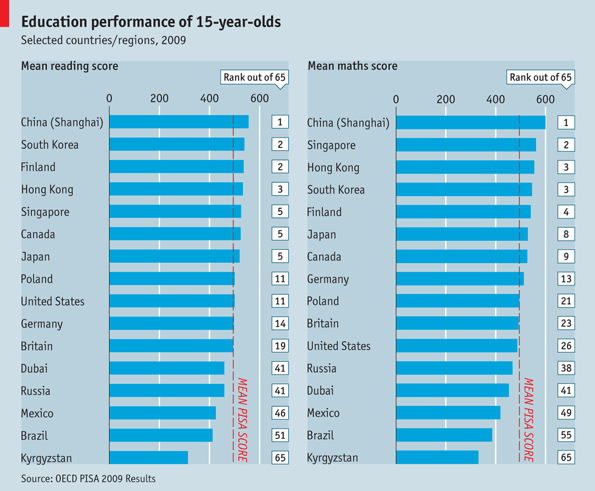
The Chinese tend to favor the American education system. NYT columnist Nicholas Kristof wrote about this “paradox: Chinese themselves are far less impressed by their school system. Almost every time I try to interview a Chinese about the system here, I hear grousing rather than praise. Many Chinese complain scathingly that their system kills independent thought and creativity, and they envy the American system for nurturing self-reliance — and for trying to make learning exciting and not just a chore.”
[ The New York Times “China’s Winning Schools?” Jan. 15, 2011 ]
29% of Americans couldn’t name the U.S. vice president, in a sampling of 1,000 U.S. citizens who took America’s official citizenship test.
[ Newsweek “How Dumb Are We?” March 20, 2011 ]

China facts: EDUCATIONAL SYSTEM
China has about 400 million students today.
[ “China: Asia in Focus”, R. LaFleur 2010]
Chinese children typically start their formal education at age two.
[ The New York Times “China’s Winning Schools?” Jan. 15, 2011 ]
By the first semester of first grade, students are expected to recognize 400 Chinese characters and write 100 of them.
[ “China: Asia in Focus”, R. LaFleur 2010]
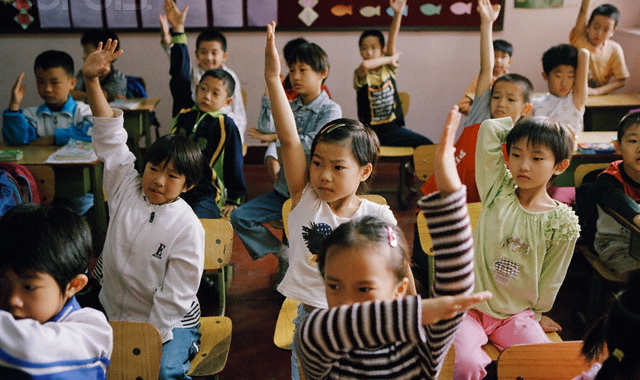
Chinese citizens must attend school for at least nine years. According to data from China’s Ministry of Education, China has a 99% attendance rate for primary school.
[ Wikipedia “Education in the People’s Republic of China” ]
Under China’s “Law on Nine-Year Compulsory Education,” primary school is tuition-free. However, students must pay a small tuition fee after the compulsory nine years of education during middle and high school.
[ Wikipedia “Education in the People’s Republic of China” ]
To boost literacy rates, the Communist party switched from “traditional” Chinese characters to a “simplified” form (using fewer strokes). Singapore also uses simplified Chinese, however, traditional characters are still used in Hong Kong and Taiwan.
[Wikipedia “Simplified Chinese characters” ]
During the early days of Mao’s Cultural Revolution (1966-76), higher education in China effectively shut down. In 1975, Deng Xiaoping reported that university graduates were “not even capable of reading a book” in their own fields after graduation.
[ Wikipedia “Education in the People’s Republic of China” ]
China did not have any private schools until the early 1980’s. Today, there are over 70,000 private schools in China of all levels and type.
[ Wikipedia “Education in the People’s Republic of China” ]
China facts: HIGHER EDUCATION
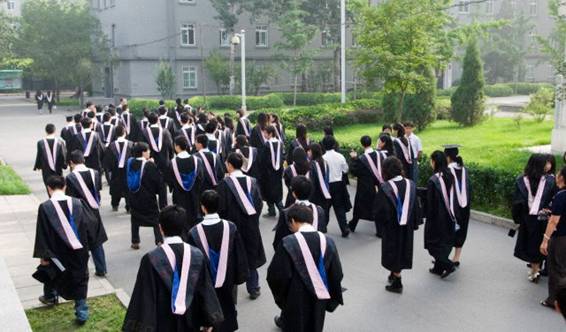
More than 60% of high school graduates in China now attend a university, up from 20% in the 1980s.
[ The New York Times “The China Boom” Nov. 5, 2010 ]
The number of students in China enrolled in degree courses has risen from 1 million in 1997 to 5 million today.
[ The Economist “A work in progress” March 17, 2011 ]
The number of higher-education institutions in China has more than doubled in the past decade, from 1,022 to 2,263.
[ The Economist “A work in progress” March 17, 2011; The New York Times “The China Boom” Nov. 5, 2010 ]
Today, China has over 2,000 universities and colleges, with over 2 million total students enrolled in higher education.
[Wikipedia “Higher education in China” ]
“Harvard Girl” (2000) was a best-selling Chinese book that was a “how-to manual” for parents on raising their children to get into top-tier universities overseas. It was written by the parents of a girl who was admitted to Harvard University, and spawned a genre of copy cat books.
[ Wikipedia “Harvard Girl” ]
China is creating their version of the Ivy League, by singling out nine of its top universities. In a 2010 speech, Yale president Richard Levin said: “This expansion in capacity is without precedent. China has built the largest higher-education sector in the world in merely a decade’s time. In fact, the increase in China’s post-secondary enrollment since the turn of the millennium exceeds the total post-secondary enrollment in the United States.”
[Time Mag. “The Real Challenge from China: Its People, Not Its Currency” Oct. 7, 2010 ]
Between 2003 and 2009, the average starting salary for China’s college graduates has stayed the same…while the starting pay for migrant workers during the same period rose by nearly 80%.
[ The New York Times “China’s Army of Graduates Struggles for Jobs” Dec. 11, 2010 ]
Chinese students (over 127,000) are the largest group of foreign students in America’s universities. But only about 14,000 American students are studying in China. However, American students studying Chinese has continued to grow steadily.
[ The Economist online “Studying the Superpower” Jan, 18, 2011]
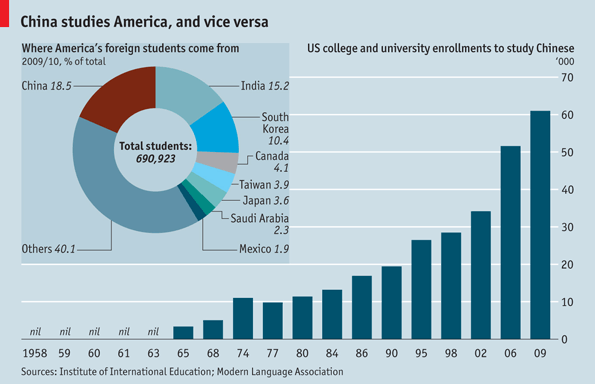
China has over 1,200,000 IT professionals and is adding 400,000 technical graduates each year. China ranks #1 in the world (followed by India and the US)
[“China Fever” F. Fang 2007 ]
China has around 170,000 certified lawyers, 12,000 law firms, and 300+ law schools.
[ “China: The Balance Sheet” Bergsten 2006 ]
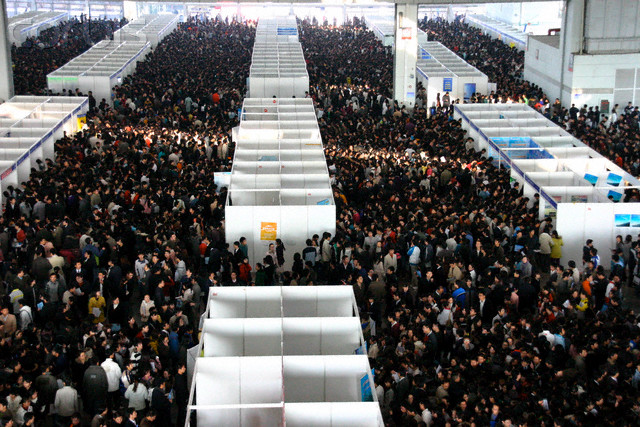 Chinese college students at a job fair in Nanjing (2008).
Chinese college students at a job fair in Nanjing (2008).
LEARNING ENGLISH & MANDARIN
China has an estimated 30,000 organizations or companies offering private English classes. In the five years between 2005-2010, the market has nearly doubled in size to be worth around US$3.1 billion.
[ Guardian UK “Battle intensifies for $2bn English-teaching business in China” July 13, 2010 ]
Since launching in 2008, Disney English has “rapidly expanded” with eight schools in Shanghai and three in Beijing—with plans to double the number of locations in the course of a year.
[ Guardian UK “Battle intensifies for $2bn English-teaching business in China” July 13, 2010 ]

About 40 million foreigners are studying Mandarin around the world…,but only 50,000 of them are in the U.S.
[ Newsweek “America’s Chinese Problem: The reports of progress are wrong” Dec. 6, 2010 ]
Most students learning Mandarin are from Japan and South Korea, according to the Beijing Language and Culture University Press (the world’s biggest publisher of textbooks on learning Chinese).
[ Newsweek “America’s Chinese Problem: The reports of progress are wrong” Dec. 6, 2010 ]
From 2007 to 2009, the number of Indonesians learning Chinese jumped 42%.
[ Newsweek “America’s Chinese Problem: The reports of progress are wrong” Dec. 6, 2010 ]
In 2010, India’s education minister proposed adding Mandarin to the state curriculum.
[ Financial Times “Turning deaf ear to Mandarin no longer wise” Oct. 3, 2010 ]
Only 4% of U.S. middle and high schools offer foreign-language instruction in Mandarin in 2008, according to a survey by the Center for Applied Linguistics. The survey also found that “13 percent of schools still offer Latin and a full 10-fold more schools offer French than Mandarin.”
[ Newsweek “America’s Chinese Problem: The reports of progress are wrong” Dec. 6, 2010 ]
In the U.S., 88% of elementary schools and 93% of middle and high schools with language programs offered Spanish.
[ Newsweek “Foreign Languages Fade in Class — Except Chinese” Jan. 20, 2010 ]
In the U.S., Chinese is only the fifth-most-popular language to learn, according to Tom Adams, CEO of the language-instruction company Rosetta Stone. In Japan and South Korea, it’s No. 2 (behind only English).
[ Newsweek “America’s Chinese Problem: The reports of progress are wrong” Dec. 6, 2010 ]




